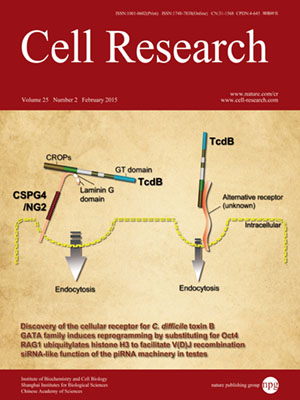
Volume 25, No 2, Feb 2015
ISSN: 1001-0602
EISSN: 1748-7838 2018
impact factor 17.848*
(Clarivate Analytics, 2019)
Volume 25 Issue 2, February 2015: 237-253 | Open Access
ORIGINAL ARTICLES
Cationic nanocarriers induce cell necrosis through impairment of Na+/K+-ATPase and cause subsequent inflammatory response
Xiawei Wei1, Bin Shao1, Zhiyao He1, Tinghong Ye1, Min Luo1, Yaxiong Sang1, Xiao Liang1, Wei Wang1, Shuntao Luo1, Shengyong Yang1, Shuang Zhang1, Changyang Gong1, Maling Gou1, Hongxing Deng1, Yinglan Zhao1, Hanshuo Yang1, Senyi Deng1, Chengjian Zhao1, Li Yang1, Zhiyong Qian1, Jiong Li1, Xun Sun1, Jiahuai Han2, Chengyu Jiang3, Min Wu4 and Zhirong Zhang1
1Key Laboratory of Drug Targeting of Ministry of Education, State Key Laboratory of Biotherapy/Collaborative Innovation Center, West China School of Pharmacy, Sichuan University, No. 17, Block 3, Southern Renmin Road, Chengdu, Sichuan 610041, China
2State Key Laboratory of Cellular Stress Biology, School of Life Sciences, Xiamen University, Xiamen, Fujian 361005, China
3State Key Laboratory of Medical Molecular Biology, Institute of Basic Medical Sciences, Chinese Academy of Medical Sciences, Department of Biochemistry and Molecular Biology, Peking Union Medical College, Beijing 100005, China
4Department of Biochemistry and Molecular Biology, School of Medicine and Health Sciences, University of North Dakota, Grand Forks, ND 58202, USA
Correspondence: Zhirong Zhang, E-mail: zrzzl@vip.sina.com; Xiawei Wei,(xiawei_wei@sina.cn)
Nanocarriers with positive surface charges are known for their toxicity which has limited their clinical applications. The mechanism underlying their toxicity, such as the induction of inflammatory response, remains largely unknown. In the present study we found that injection of cationic nanocarriers, including cationic liposomes, PEI, and chitosan, led to the rapid appearance of necrotic cells. Cell necrosis induced by cationic nanocarriers is dependent on their positive surface charges, but does not require RIP1 and Mlkl. Instead, intracellular Na+ overload was found to accompany the cell death. Depletion of Na+ in culture medium or pretreatment of cells with the Na+/K+-ATPase cation-binding site inhibitor ouabain, protected cells from cell necrosis. Moreover, treatment with cationic nanocarriers inhibited Na+/K+-ATPase activity both in vitro and in vivo. The computational simulation showed that cationic carriers could interact with cation-binding site of Na+/K+-ATPase. Mice pretreated with a small dose of ouabain showed improved survival after injection of a lethal dose of cationic nanocarriers. Further analyses suggest that cell necrosis induced by cationic nanocarriers and the resulting leakage of mitochondrial DNA could trigger severe inflammation in vivo, which is mediated by a pathway involving TLR9 and MyD88 signaling. Taken together, our results reveal a novel mechanism whereby cationic nanocarriers induce acute cell necrosis through the interaction with Na+/K+-ATPase, with the subsequent exposure of mitochondrial damage-associated molecular patterns as a key event that mediates the inflammatory responses. Our study has important implications for evaluating the biocompatibility of nanocarriers and designing better and safer ones for drug delivery.
10.1038/cr.2015.9
FULL TEXT | PDF
Browse 2389


